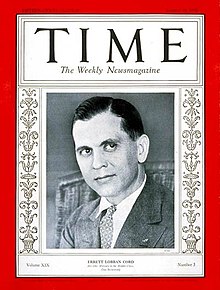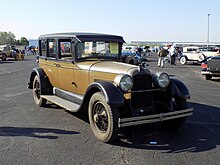Errett Lobban Cord

Errett Lobban Cord (born July 20, 1894 in Warrensburg , Missouri , USA ; † January 2, 1974 in Reno , Nevada ) was an industrialist and entrepreneur with interests mainly in the US transportation system.
origin
His family had Scottish roots .; his parents were the plantation owner Charles W. Cord (1854-1911) and Ida Lobban Cord (1864-1955). The family moved several times and lived in Los Angeles in 1911, the year the father died .
Career start
Here he left school at the age of 17 and worked as a car salesman and gas station attendant. He expanded his field of business by processing used cars and selling them on his own account; He also drove car races with modified Ford Model T and prepared his and other vehicles. His clients also included greats from the Hollywood film business . There is only imprecise information about his early professional career. He was happy to be quoted as saying that he had amassed and lost US $ 50,000 in fortunes in three different industries before he was 21 years old.
Quinlan Motors and Moon
Around 1918 he went to Chicago , Illinois , where he first sold trucks and then automobiles, most recently at Quinlan Motor Company , the regional agent for the Moon car brand . Here he was so successful that he was able to participate in the company and took over the management of the company around 1922. The company became the most successful Moon agency. He founded Dealer's Sales Corporation in Chicago and got 15 local Moon dealers to contribute US $ 15,000 each. The company had an exhibit in a good location in Chicago, and dealers would send customers here to see cars they couldn't show in their small dealerships. If the customer bought here instead of from them, they would earn on the dividends from Dealer's Sales Corporation . Another idea was to upgrade a special model with accessories and to sell it at a special price. This is how the Winsome , a Moon 6-40 Touring with a fixed roof, was born.
At Moon you followed the development and Quinlan also took over the area representation for Wisconsin and northern Michigan . Associated with this was a move from Cord to Milwaukee , Wisconsin.
Auburn
With his participation and his private assets, Cord had a good financial cushion and was now looking for a new professional challenge at an automobile manufacturer. John Quinlan put the connection with Ralph Bard , one of the investors in the Auburn Automobile Company .
Although there were 122 automakers in the United States in 1922, the market was very concentrated. Only six car manufacturers together produced 85% of all cars - Ford alone 55%; General Motors , Dodge Brothers , Studebaker , Willys-Overland and Hudson combined by 30%. At the other manufacturers, including Auburn , between a few dozen and a few thousand vehicles left the factory each year. Founded in 1900, Auburn was one of the oldest car manufacturers in the country. The company enjoyed a good reputation and was to an investor group in 1919 William Wrigley Jr. had been sold. Since the record result this year with 6,062 vehicles built, sales had slumped by more than half by 1923. In 1924 only six automobiles were built a day, and only some of them could be sold. Auburn was not ready for bankruptcy with sufficient resources, but it was ailing and had the right leadership to turn the tide. Up to 700 cars were allegedly on the dump.
EL Cord came to Auburn on July 15, 1924 and took several weeks to analyze and work out his measures. His report was well received and Cord received a contract offer for an annual salary of US $ 36,000. However, he declined to be hired on a salary basis and proposed a 20% profit-sharing option instead; In addition, if successful, he demanded the right of first refusal on the company's bearer shares , which would secure control for him, and a free hand in his decisions. The owners reluctantly agreed and from September 1924 Cord was vice president and managing director.
Cord achieved the sale of the vehicles lying on the dump by simple means. The vehicles have been visually upgraded with nickel-plated radiator grills, more attractive colors and affordable prices. The stock vehicles could be sold within a few weeks. In 1925, eight-cylinder models were introduced for the first time with the 8-63 and 8-88 .
3,735,171 automobiles were manufactured in the United States in 1925, 17.24% more than the previous year. Auburn contributed 5,599 of these. For the small manufacturer that was an increase of 114.8%. With the help of the broker Lucius B. Manning , Cord brought the Auburn stock to the Chicago Stock Exchange as early as 1925 . As of November 1, 1925, Auburn was debt free. At the General Assembly on February 1, 1926, Errett Cord was elected President.
Auburn also doubled its output in 1926 and 1927.
Significant acquisitions
In October 1926, Cord acquired Duesenberg, Inc. in Indianapolis and saved the company from bankruptcy after a failed reorganization. In September 1927 it became part of a combine of Duesenberg, the engine manufacturer Lycoming Manufacturing Company and the Limousine Body Company . In May 1928, Cord acquired a majority stake in the Central Manufacturing Company body shop .
Cord Corporation
From his ventures he formed the Cord Corporation on June 14, 1929 . In the end he controlled over 150 companies, including a. also the later American Airlines .
Airlines
In late 1930, Errett Cord announced the formation of Century Air Lines in Chicago, a mail and cargo airline. They ordered 100 Stinson aircraft with Lycoming engines. In early 1932, the Aviation Corporation (AVCO, parent company of American Airways ) attempted a hostile takeover of Century . Cord was not very pleased and for his part began secretly to buy up AVCO shares and presented himself in autumn 1932 as a new major shareholder who now controlled both AVCO and Century with a stake of 34% .
In 1935 there was a restructuring in which the Cord Corporation became part of AVCO .
In 1937 he had to withdraw from this business to prevent a hostile takeover.
Cord stayed in Great Britain from 1934 to 1936. In 1936 he withdrew from the business and sold his shares in 1937 to Emanuel & Co. , Schroder, Rockefeller & Co. and a group of business people around Lucius Manning. In 1937, the adjustment was announced all car activities, and in 1938 took over Felz Motor Company stocks of spare parts from Duesenberg, Inc. The Dallas Winslow, Inc. purchased the rights to Auburn and Cord as well as the remaining inventory of these brands. She passed the entire package on to businessman Glen Pray in the early 1960s.
Next life
He withdrew completely to the west coast, where the architect Paul Revere Williams had built a huge property with 16 bedrooms and 22 bathrooms for him in 1932 and built a radio empire in California and Nevada .
In the 1940s, Erret Cord served briefly in the Nevada Senate .
Classic car enthusiasts are familiar with Cord from the then innovative Auburn 851 "Boattail" Speedster, Cord L-29 and Cord 810 .
Honors
- Erret Lobban Cord was featured on the cover of Time magazine twice : January 18, 1932 and April 23, 1934.
- He was inducted into the Automotive Hall of Fame in 1976 .
literature
- Halwart Schrader (Ed.): Motor Men: People, myths and engines of automobile history. Motorbuch Verlag, Stuttgart, 1st edition, 2011; ISBN 3-613-03202-3 .
- Hans Christoph von Seherr-Thoss : Dictionary of famous personalities in the automobile world. Ivy House Publishing, Raleigh NC, USA, 1st edition; 2005; ISBN 1-57197-333-8 .
- Don Butler: Auburn Cord Duesenberg. Crestline Publishing Co., Crestline Series , 1992; ISBN 0-87938-701-7 .
- Jon M. Bill: Cord Automobiles: L-29 & 810/812 Photo Archive. Enthusiast Books, 2004 ISBN 1-58388-102-6 .
- Jon M. Bill: Duesenberg Racecars & Passenger Cars Photo Archive. Auburn Cord Duesenberg Museum (Ed.), Iconografix, Hudson WI, Photo Archive Series; ISBN 1-58388-145-X .
- Louis William Steinwedel, J. Herbert Newport : The Duesenberg: The Story of America's Premier Car. Chilton Book Co, 1st Edition, 1970; ISBN 0-8019-5559-9 .
- Beverly Rae Kimes (ed.), Henry Austin Clark Jr.: Standard Catalog of American Cars 1805-1942. 3. Edition. Krause Publications, Iola WI 1996, ISBN 0-87341-428-4 .
- ACD Museum (Ed.): 19th Annual Auburn Cord Duesenberg Festival; Official Souvenir Book ; Brochure for the opening of the Auburn Cord Duesenberg Museum in Auburn, Indiana (USA), Labor Day Weekend 1974.
- Dennis Adler: Duesenberg. Heel-Verlag, Königswinter, 2005; ISBN 3-89880-487-9 .
- Brooks T. Brierley: Auburn, Reo, Franklin and Pierce-Arrow versus Cadillac, Chrysler, Lincoln and Packard. Garrett & Stringer, Inc. Coconut Grove, Florida, 1st Edition; ISBN 0-9615791-1-0 .
- Griffith Borgeson: The Golden Age of the American Racing Car. Ed. SAE ( Society of Automotive Engineers ), Warrendale PA, 2nd edition 1998; ISBN 0-7680-0023-8 .
- Nicky Wright: Art of the American Automobile. Prion Books Ltd, 1995; ISBN 1-85375-163-4 .
Web links
- coachbuilt.com: Limousine Top Company, 1914-1920; Limousine Body Company, 1920-1933; Kalamazoo, Michigan; 1933-1936; Connersville, Indiana . (English) (accessed November 30, 2017)
- automaven.com: CordNnet brand history (accessed January 19, 2013)
- Erret L. Cord in Automotive Hall of Fame , (accessed November 28, 2017)
- Paul R. Williams Project: Residence EL Cord, Beverly Hills. (English), (accessed November 28, 2017)
- Errett Lobban Cord in the Find a Grave database . Retrieved July 2, 2018.
Individual evidence
- ↑ a b Butler: Auburn Cord Duesenberg. 1992, p. 6.
- ↑ Errett Lobban Cord in the Find a Grave database . Retrieved July 2, 2018.
- ↑ a b c d Butler: Auburn Cord Duesenberg. 1992, p. 90.
- ↑ a b Kimes, Clark: Standard Catalog of American Cars 1805-1942 , 1996, pp. 377-378 (Cord).
- ↑ a b Butler: Auburn Cord Duesenberg. 1992, p. 113.
- ^ Butler: Auburn Cord Duesenberg. 1992, p. 114.
- ↑ a b c d Kimes, Clark: Standard Catalog of American Cars 1805-1942 , 1996, p. 70 (Auburn).
- ↑ a b c d e Butler: Auburn Cord Duesenberg. 1992, p. 132.
- ↑ a b c d e f g h i coachbuilt.com: Limousine Body Company.
- ^ Butler: Auburn Cord Duesenberg. 1992, p. 140.
- ^ Seherr-Thoss: Dictionary of famous personalities in the automobile world. 2005, p. 34 (EL Cord).
- ↑ a b Automotive Hall of Fame: Erret L. Cord.
- ^ Paul R. Williams Project: Residence EL Cord, Beverly Hills.
| personal data | |
|---|---|
| SURNAME | Cord, Errett Lobban |
| BRIEF DESCRIPTION | American entrepreneur |
| DATE OF BIRTH | July 20, 1894 |
| PLACE OF BIRTH | Warrensburg , Missouri, USA |
| DATE OF DEATH | 2nd January 1974 |
| Place of death | Reno , Nevada |



